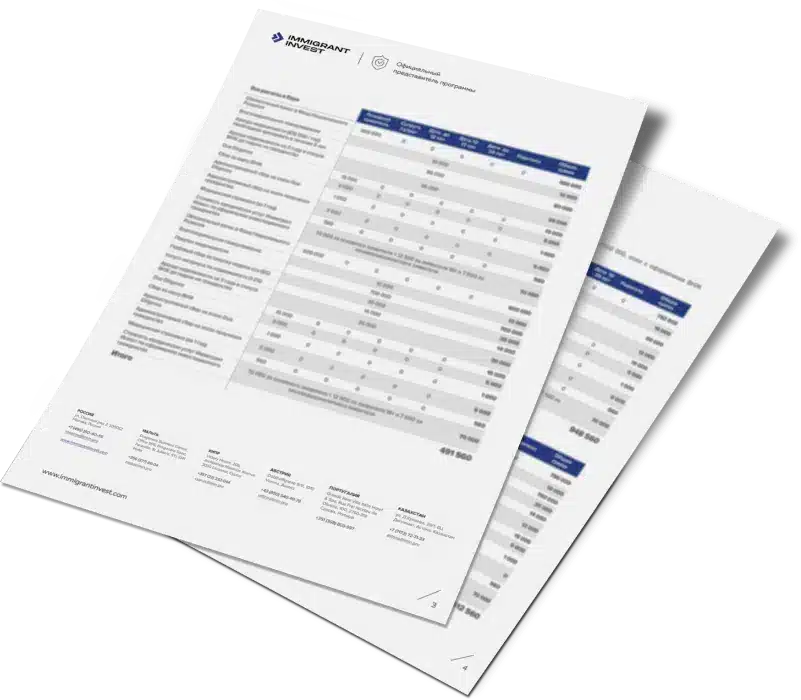Antigua and Barbuda is a Caribbean island nation with a developed economy and a high level of medicine and education. Cosmopolitans come to the islands for secluded beaches, walks in the rainforest and yachting in the Caribbean Sea.
The country is developing through tourism, agriculture and investment: foreigners obtain Antigua and Barbuda citizenship for visa-free travel to the Schengen countries, the UK, Singapore and Hong Kong.
Geographical facts about Antigua and Barbuda
Antigua and Barbuda is located on three islands in the eastern Caribbean Sea and the northern part of the Lesser Antilles: Antigua, Barbuda and Redonda.
Antigua is the largest of the islands with a developed infrastructure. The highest point on the island, at 402 metres, is Mount Obama, which until 2009 was called Boggy's Hill.
The island of Barbuda is flatland. The maximum height of the hills reaches only 32 metres. It is an island of coral origin, and the beaches have much pink sand.
Redonda is an uninhabited rocky island, and its length is only 2 kilometres. You can visit this nature reserve but must stay on the island for a while.
Main facts about Antigua and Barbuda:
- area — 442 km²;
- capital — St. John's;
- average annual temperature ― +28℃;
- the most comfortable months are April, May, and June;
- the population is about 100,000 people;
- the official language is English;
- the national currency is the Eastern Caribbean dollar.
Political and economic structure in the country
Antigua and Barbuda is a former British colony that gained independence in 1981. Now the state is part of the Commonwealth, so the monarch of the UK is listed as the head of Antigua and Barbuda. Their interests are represented by the Governor-General, appointed at the suggestion of the country's Prime Minister.
The executive power in the country is exercised by the Government, which the Prime Minister heads. And the legislative one is the Government and Parliament of two chambers: the Senate and the House of Representatives.
In 2013, the Government launched the Antigua and Barbuda Citizenship by Investment Programme. Thanks to the project, investments in tourism, the island's infrastructure and the social sphere are growing.
In addition to the Commonwealth, Antigua and Barbuda is a member of the UN, CARICOM and the Organisation of American States. Citizens of Antigua and Barbuda travel visa-free within the Schengen Area, the UK, Hong Kong, and Singapore.
Most of Antigua and Barbuda's population is of African origin, but the descendants of the Arawak and Caribbean Indians also remained on the islands. A small percentage of the people are European settlers and immigrants from Asia and North America.
The country's official language is English, but in everyday life, you can often hear local dialects, and some of the inhabitants also understand the Franco-Creole language.
The Antigua and Barbuda citizens are predominantly Christians — 93%. But there is a small percentage of residents who profess Islam (0.6%), Hinduism (0.2%), folk beliefs and other religions (4.5%), or atheists (1.7%).

The backbone of Antigua and Barbuda's economy is tourism, agriculture and the citizenship investment program.
Tourism brings about 60% of the country's GDP, so the government is investing in developing tourism infrastructure: it improves the appearance of the state and builds earthquake-resistant buildings and new hotels.
Residents grow various crops both for themselves and for export. In the lowlands of the islands, there are fruit plantations and vegetable gardens.
Climate and nature of Antigua and Barbuda
The climate in Antigua and Barbuda is tropical. It is warm, soggy, sometimes windy, and partly cloudy. The best time to visit the country is in April, May and June.
The rainiest period is from September to November, with droughts from February to April. Hurricanes come to the country from July to October.
The temperature on the islands is stable and seldom drops below +20℃.

The nature of the islands is vivid: tropical forests, picturesque bays, evergreen hills and snow-white beaches with coral reefs along the coast.
Antigua has a developed infrastructure, so many forests have been cut down. But nature in Barbuda is approximately 70% preserved in the wild.
On the hills and in the lowlands of the islands, cacti, palm trees, and domestic crops coexist. There are no rivers and lakes in the country's territory, and drinking water is extracted from artesian sources.
Deer and wild boars live in the tropical forests of Barbuda, while livestock is more common in Antigua: goats, rabbits, donkeys and cows; the latter, however, are rare.
The fauna of Barbuda is more diverse: in the northwest, there is a Frigate Bird Sanctuary, which is home to more than 170 species of birds.
There are about 450 species of fish in the Caribbean Sea. Tourists come to Antigua for stingray diving.
Best cities to live in Antigua and Barbuda
Antigua and Barbuda cities and resorts offer a tropical sanctuary with gentle trade winds, gorgeous beaches, and various visitor-friendly activities like dining, shopping, and sightseeing historical sites.
You may stroll through cities that have been fully developed, with excellent restaurants and unique shops lining pedestrian-friendly streets. You can visit spotless beaches with pink sand.
St. John's is the biggest city with many entertainment options, including bars, restaurants, and stores. There is abundant contemporary infrastructure and many homes, including upscale waterfront real estate.
Dickenson Bay is a lively town with much nightlife but has exclusive gated neighbourhoods with luxury homes. The world of water sports has grown significantly.
Jolly Harbour is a very contemporary resort town with a robust infrastructure. There’s a water park, a gold court, a tremendous marina, and a good selection of waterfront real estate.
Infrastructure, prices, and living on the islands
Airport. VC Bird International Airport operates in Antigua and Barbuda. It is located 6 km from the capital of St John's on the island of Antigua. About 30 flights are made daily, including local flights to the neighbouring island, Barbuda.
There are two domestic airports in Barbuda: the state airport in Codrington and the private Point Lodge near Cape Coco.
Residential real estate. Tourists stay in hotels and apartments or rent apartments from residents. Renting a one-room apartment in the capital starts from $600. The closer to the centre, the higher the rent.
Beaches. Antigua and Barbuda is called the land of 365 beaches. Beach lovers can change locations every day.
Antigua has a more developed infrastructure: many hotels, shops, restaurants, nightclubs, and casinos. It is optional to leave tips in local cafes and restaurants, as they are usually included in the bill.

Transport. Bus routes connect settlements within Antigua or Barbuda; a ticket costs about $1. You can order a taxi on the islands, costing $1.5 per mile.
The islands are connected with a ferry service. A return ticket for the Barbuda Express ferry costs $120.
Prices in the country are relatively low, but imported goods are always more expensive. A trip to a mid-range restaurant with a three-course menu for a couple will cost $95.
Average grocery prices in Antigua and Barbuda stores are the following:
- bread, 500 g — $2.65;
- milk, 1 litre — $ 1.85;
- local cheese, 1 kg — $6.55;
- eggs, 12 pieces — $4;
- chicken fillet, 1 kg — $ 6.7;
- beef, 1 kg — $14.85;
- apples, 1 kg — $ 12.2;
- bananas, 1 kg — $ 2.5;
- mid-range bottle of wine — $11;
- cappuccino — $5.2.
A monthly membership to a fitness club will cost $65, and a movie ticket will cost $6.75.
Education. The country has public and private schools. Children from 5 to 16 years old can study for free. Special schools are also open: pedagogical, technical, and craft, for children with special needs.
There are several universities in Antigua. The most famous is the branch of the University of the West Indies, the American Medical University and the Institute of Information Technology.
The University of the West Indies is a higher education institution operating in the British Commonwealth of Nations states. The university campus is located 7.5 km from the capital St John's. Students study mathematics, economics, banking, accounting and taxes, information technology, management and tourism.
The Government of Antigua and Barbuda offers scholarships to students from six Organisation of the Eastern Caribbean States countries.
Medicine. Antigua and Barbuda has a high healthcare level based on British medical standards. The country has 10 hospitals and clinics with modern equipment.
The hotels also have doctors. When travelling to the country, it is recommended to take out insurance, as medical services on the island are expensive. For example, an appointment with a private doctor costs $80.
Yachting. Yacht owners choose Antigua and Barbuda for boat storage. Arriving yachts, boats and liners are moored in specially equipped marinas. The country has several large ports and many small marinas.
You can come to the islands on a cruise ship and on your yacht. The primary marinas are English Harbor and Falmouth.
Antigua and Barbuda taxes
Antigua and Barbuda tax residents do not pay taxes on wealth, inheritance and capital gains. Social contributions of individuals amount to 5.5%.
Real estate and land purchases are subject to tax. Foreigners who purchase real estate in the nation must pay a licence fee. However, foreign investors who gain Antigua and Barbuda citizenship by investment do not pay it.
Stamp duty when buying property is 7.5% for the seller and 2.5% for the buyer. The annual property tax for owners is 0.1—0.5%, depending on the property type.
The corporate tax rate is 25% for companies registered or managed in Antigua and Barbuda. Commercial banks, insurance, energy, and telecommunications industries are subject to a reduced corporate tax of 10%.
The VAT equivalent, known as the Antigua and Barbuda Sale Tax, or ABST, is included in the price of products and services. It has a 15% fixed rate.
Social contributions for employers are 6% of an employee’s wage.
Attractions, festivals and entertainment
Holidays on the islands of Antigua and Barbuda are suitable for anyone: 365 beaches for lovers of a relaxing holiday on the seashore; restaurants, clubs and shops for those who want to know the life of the locals. For those interested in history, there are museums and forts. Tourists who prefer active recreation go on sea or hiking trips.
Attractions. The Devil's Bridge was built on the island of Antigua and is one of the country's main attractions. It was built in the 16th century from limestone and is known for sad events. From a sheer cliff, enslaved people jumped into the sea, hoping to gain freedom at the cost of their lives.
One of the important architectural monuments is St John's Cathedral: an Anglican church located on a hilltop in the capital. Earthquakes destroyed it twice; the last reconstruction was carried out in 1845. The church's interior is made of pine to protect the building from the destruction caused by natural disasters.
The Court House is the Antigua and Barbuda Museum in St John's. Tourists can get acquainted with the collection of exhibits dedicated to the history and culture of local tribes and the colonial period.
Fort James is a fortress located next to St John's harbour. English colonists built the citadel to guard the harbour in the 18th century.
Nelson Shipyard is a place where naval vessels are built and repaired. Enslaved Africans built the shipyard in 1725. It is still in operation and accepts various ships for repairs.
The shipyard got its name after the reconstruction in 1930, called the shipyard of His Majesty. In 2016, UNESCO took the shipyard and architectural monuments next to it under protection.
Resorts. One of the most extensive beaches in Antigua is Galleon, where there are always a lot of locals and tourists. Hotels have been built on the shore, and shares are bought under an investment program.
Tourists recognised Jolly as the most soulful beach: hotels and restaurants are open on the coast, and the water is calm and clear — ideal for families with children.
The main resort of the island of Barbuda is the ancient town of Codrington. It has many iconic places and attractions. For example, the government house was built in 1694. Locals consider it a symbol of the city.
On the hill rises Codrington House, an 18th-century building. In the past, the house served as a slave estate. Several buildings have survived. Nearby there is an observation deck, one of the largest in the state.
On the island of Barbuda is the Martello Tower, which got its name from the name of the class of defensive structures of the 18th—19th centuries around the world. Cannons were installed inside the tower, and up to 30 soldiers watched the surroundings and fired at the enemies in the event of a siege.
The only source of freshwater formerly used by the Indians is in Derby Cave. Underground passages to other caves, such as Drop Cavern and Bath Charmer, connect the cave. Indian Cave is a prehistoric site in Barbuda, with many stalactites and fossils inside and petroglyphs painted on its walls.
The third island of the state, Redonda, has been transformed into a national park, home to many seabirds. Mountain goats graze on the rocks.
Festivals and entertainment. The inhabitants of the islands love cricket, which has been played since the English colonists. The team representing the country in the Leeward Islands Cricket Championship was formed in the late 1890s.
In May, English Harbor hosts Antigua Sailing Week, the most prestigious and famous regattas in the Caribbean. The first regatta was held in 1967, and only ten yachts from the island of Antigua yacht clubs took part. Today, hundreds of crews from different countries.
The Antigua Classic Yacht Regatta and the Antigua Charter Yacht Show also occur in English Harbor. Antigua Classic Yacht Regatta starts a week before the country's main regatta on the last Sunday in April.
Dickenson Bay, Antigua hosts windsurfing competitions in January and July.
Festivals are often held in Antigua and Barbuda. In February, locals celebrate the Day of Vadadia, local culture, and the Day of Seafood in April. Today, you can participate in a fisherman's or mango-eating contest.
At Easter, Antigua hosts a kite festival, symbolising spring's beginning.
Top 10 interesting facts about Antigua and Barbuda
- The indigenous names for Antigua and Barbuda are Waladli and Wa'omoni.
- Locals in Antigua pronounce the island "Anti-ga." The "U" is essentially dropped, although the Spanish pronunciation of the word is "Anti-gwa."
- Antigua's official language is English because it was a British colony for a long time. Patois, the locals' native English vernacular, is comparable to Jamaican Creole. In the Leeward Islands, this language is spoken by about 150,000 people.
- The native currency is the Eastern Caribbean Dollar (US$1=EC$2.70), although US dollars are widely accepted everywhere. But you're not required to exchange it.
- Fungee is the national dish that resembles polenta. It is made from cornmeal with butter and tangy tomato sauce and is often served with a meat and pepper pot dish.
- Hot sauces are extremely popular in the country, so remember when trying local meals for the first time. Susie’s Hot Sauce is one of the most popular varieties.
- The country has 51 small offshore islands with peculiar names such as Redhead, Rabbit, Galley, Lobster, “Jenny”, Great Bird, and Hellsgate.
- Antigua and Barbuda is a “female land” with 93.4 males per 100 females, approximately 3,400 more women than men.
- Local English has a charming proverb: “The Moon runs fast, but the day will catch it”. The meaning of the proverb is that your actions will eventually have consequences.
- There are no snakes in the country except for a non-venomous Antiguan racer snake endemic to Bird Island.
Antigua and Barbuda passport benefits
The Antigua and Barbuda passport prevents the investor from applying for a visa to travel to 150 countries. The list of visa-free countries includes the Schengen states, the EU, Hong Kong, Singapore, and the UK.
The Antigua and Barbuda Citizenship by Investment Programme was launched in 2013. The government provides investors with a choice of four investment options:
- Non-refundable contribution of $100,000 to the National Development Fund.
- Purchase of real estate in the amount of $200,000.
- Investment from $1,500,000 in a government-approved business project.
- A non-refundable contribution of $150,000 to the University of the West Indies Fund for a family of six or more.
Investors who have chosen the real estate option buy apartments, villas or shares in five-star hotels or shares in the construction of urban infrastructure facilities.
Developers and their projects are carefully checked. Those who pass the test are included in the approved list, which is published on the official website of the CBI Unit.
After 5 years, the investor can sell the asset and return most of the money. If the investor decides to rent out the property, they will be able to receive an income of 2 to 5% per annum. The management company is in charge of maintaining the property.
The non-refundable contribution is one of the best deals among Caribbean citizenship programs.
In addition, the investor needs to pay for a due diligence check, legal services for paperwork, and pay state fees and duties.
Frequently Asked Questions
Yes, It’s always warm, and the locals are friendly. Having a yacht and sailing it there is a wonderful experience.
The country is considered a member of the Commonwealth, an intergovernmental alliance of countries formerly known as the external territories of the British Empire. Because of this, the official language in the country is English, while many citizens still commonly use their Caribbean creole language.
To legally work on islands, foreigners need a work permit if they are not permanent residents or citizens of Antigua and Barbuda.
No, but Antigua and Barbuda tax residents do not pay taxes on wealth, inheritance and capital gains.
The tax is levied on the purchase of real estate and land. Foreigners who buy property in the country pay a licence fee. But foreign investors who obtain Antigua and Barbuda citizenship by investment do not pay it.
The Antigua and Barbuda passport opens up the possibility of visa-free travel to 150 countries. For example, with a second passport, investors do not need to obtain visas to travel to the EU and Schengen countries, Great Britain, Hong Kong and Singapore.
Foreign citizens acquire citizenship of Antigua and Barbuda by naturalisation, by marriage to a citizen of the country or by investment. Participating in the state investment program is the fastest way to move to Antigua.
The minimum contribution amount is $100,000. Investments in real estate start from $200,000, and in business — from $1,500,000.
If investors choose the real estate option, then after 5 years, they have the right to sell the object or their share in it. During this time, the property can be rented out. Income from rent reaches 4% per annum.
Under the program, investors can buy apartments, villas or shares in hotels, as well as share in the construction of infrastructure like a pier.
Antigua and Barbuda is an island nation located in the eastern part of the Caribbean Sea. The country consists of a volcanic island Antigua, coral Barbuda and rocky Rodonda. They are part of the Lesser Antilles.
The Antigua and Barbuda passport allows the investor not to apply for a visa to travel to 150 countries. The list of visa-free countries includes the states of the Schengen Area, the EU, Hong Kong, Singapore, and the UK.
The children of investors will be able to study on preferential terms in educational institutions in the UK since Antigua and Barbuda is a member of the Commonwealth.
If desired, investors can become tax residents of the state and optimise their taxes. Investors will not have to pay taxes on capital gains, inheritance and wealth.
More than a month is needed for guests of the country to see all the sights of Antigua and Barbuda.
St. John’s is not only the state’s capital but also the cultural centre of the islands. The city has many historic wood and stone structures, such as in the Redcliffe Kwai area. Most of the buildings are now open to museums and exhibitions. Also in the city is the cathedral of the 18th century, the Cathedral of St John the Evangelist, which was built of wood and stone in the Baroque style.
On the island of Barbuda, tourists are particularly interested in the main resort, the ancient city of Codrington. The town also has preserved buildings from the 17th—18th centuries, such as the government house and Codrington House, a former slave estate.
One of the most extensive beaches in Antigua is Galleon, which is always full of locals and tourists. Hotels have been built on the shore, a share bought under the citizenship program.























 Zlata Erlach
Zlata Erlach